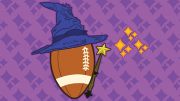Heroes are recognized in many different ways, but there’s no better representation of how heroes are worshipped than sports.
Take the Lombardi Trophy — the Super Bowl award named after a legendary coach. Vince Lombardi’s accomplishments were so revered and his body of work so influential that his name was deemed deserving of being engraved on every championship trophy given out since the year he passed away. He has come to represent striving for perfection, as every young football player dreams of hoisting his trophy.
Young sports fans should grow up with a strong sense of appreciating history as every professional league is steeped in tradition. Being a fan means being invested in the present, while paying respect to the innovators and heroes of the game — whether they’re local, national or internationally recognized.
As a Winnipeg sports fan growing up in the ’90s, I ended up having to live vicariously through stories and highlight tape preserved by earlier generations. I missed out on feverishly following Teemu Selanne’s stats in the sports section, but I watch the highlight of him breaking Mike Bossy’s record like I’m reliving a fond memory. I’ve also never been to a Grey Cup celebration in Winnipeg, but I know where to go to take part in a proud civic tradition.
As a younger kid, I’d emulate my heroes by deking invisible defensemen on the driveway with an old wooden hockey stick, or sidestepping a would-be two-hand tackle out on the field at recess. It’s a big reason why Roch Carrier’s The Hockey Sweater story and its accompanying NFB short film are so relatable.
My sports heroes growing up were Eric Lindros from the Philadelphia Flyers and the legendary pig-skin-slinger Brett Favre from the Green Bay Packers.
As an athlete’s career comes to a close, sports media and fans debate their legacy. Lindros and Favre were no different — both have had their careers scrutinized since leaving their respective sports. I’ve tried to not let my memories be tainted by the criticisms.
Inevitably there comes a moment when emerging heroes from your own generation surpass the sports heroes from your childhood. I’m sure it would have eventually happened to the young boy in Carrier’s story, just as it’s happened to me. Suddenly, Jonathon Toews from Dakota Community Centre is raising the Stanley Cup as a Chicago Black Hawk and former Oak Park Raider Andrew Harris achieved something his idol Charlie Roberts never did as a Winnipeg Blue Bomber, hoisting the Grey Cup with the BC Lions this past November.
It’s a surreal realization, but I digress.
As I looked for additional sports and athletes to follow in the mid-2000s, I began to follow a quirky young up-and-coming tennis player from Serbia, Novak Djokovic. He was quietly shooting up the ATP rankings, waiting in the wings during the height of the Federer-Nadal rivalry.
I can’t recall what specifically drew me to the Djoker but I followed him in tournaments and watched his matches. I cheered him on from my home as his proficiency on the court improved, and enjoyed his humble and humurous behavior during post-match interviews.
But for all his talent and personality, Djokovic still had critics who said he was too soft, or that he lacked the stamina and toughness to reach the pinnacle of tennis. I personally refused to buy into these theories and remained confident that Djokovic was on the cusp of greatness. As he sitting just behind Nadal and Federer in the ATP rankings for three years, I patiently waited for my tennis hero’s time in the spotlight. Flash forward to 2011.
Last year may well have been the year of the Djoker, as he took the tennis world by storm, starting the year winning 43 straight matches and three of the four tennis Grand Slams. During Wimbledon, he finally overtook Nadal at number one in the ATP rankings.
2012 is shaping up to be an even bigger year for Djokovic. He’s got an opportunity to do what no man has done since 1969 — win all four Grand Slam tournaments in a single calendar year. He’s already won the Australian Open, after outplaying Nadal in a nearly six-hour final match, and looks as good as he’s ever been in competition.
I can only hope that he’s inspiring and entertaining the younger generation of sports fans from Serbia — and around the world — like my childhood sports heroes did for me.




